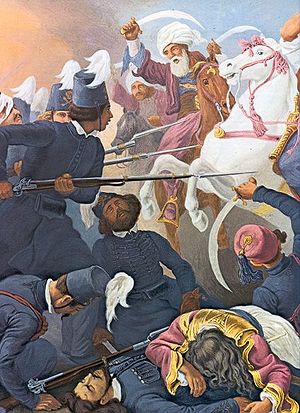Battle of Dragatsani
| Battle of Dragashani | |||||||
|---|---|---|---|---|---|---|---|
| Part of the Greek War of Independence | |||||||
 The Sacred Band fights in Dragatsani by Peter von Hess, Benaki Museum, Athens, Greece |
|||||||
|
|||||||
| Belligerents | |||||||
|
|
|
||||||
| Commanders and leaders | |||||||
|
Alexandros Ypsilantis Nikolaos Ypsilantis Giorgos Karavias Giorgakis Olympios |
Kara Faiz | ||||||
| Strength | |||||||
| 300 soldiers | 5000 soldiers, 2500 cavalry and 4 cannons | ||||||
The Battle of Dragashani (or Battle of Drăgășani) was fought on 19 June 1821 in Drăgășani, Wallachia, between the Ottoman forces of Sultan Mahmud II and the Greek Filiki Etaireia insurgents. It was a prelude to the Greek War of Independence.
Alexander Ypsilantis and the Etaireia had carried out an invasion of the Ottoman-dominated Danubian Principalities of the Ottoman Empire, which coincided with an uprising in Wallachia. Ypsilantis, a general in the Russian Army and aide-de-camp to Tsar Alexander I, had hoped that his actions would cause the Russian Empire to intervene on his behalf, but the Emperor, a leading proponent of the Concert of Europe, disavowed any relation with him and effectively gave the Ottomans the "green light" to march into the Principalities to deal with the insurrection. At the same time, Ypsilantis clashed with the Wallachian Pandur leader Tudor Vladimirescu, who was ultimately executed by the Etaireia and its remaining Wallachian supporters, leaving the Wallachian rebel troops to withdraw from the conflict.
At the village of Drăgășani, the "Sacred Band" (a volunteer unit mostly made up of young Greek students from both upper and middle classes led by Nikolaos Ypsilantis and Athanasios Tsakalov) was ultimately defeated by the Ottomans.
...
Wikipedia
